World Owl Species: 151 Owls in Canada Species: 16
Size: 35–50 cm (14″–20″), Wingspan to 1.1 m (42″), Weight 460 gr (1 lb)
Nest: Coastal British Columbia south of Vancouver, southern Ontario
- Crow-sized owl with white, heart shaped face, dark eyes and long legs
- Rusty brown above, white or light below with fine, dark dots
- Darkest birds are always females, palest birds are males
- The most widely distributed owl in the world
- Mice make up 75% of their diet
- Strictly nocturnal, roosting during the day in cavities or farm buildings
- Pairs mate for life
- Voice is a long, hissing shriek
- Do not build a nest, but lay 5-10 white eggs directly on floor of cave, cavity or building rafter
- If food is scarce they lay fewer eggs, or don’t breed at all
- When being fed, young birds utter a hissing note like the sound of escaping steam
- Lifespan up to 17 years
- Endangered due to loss of habitat, lack of nesting sites
Size: 42–60 cm (17″–24″), Wingspan to 1.2 m (50″), Weight 720 gr (1.6 lb)
Nest: British Columbia, northern Alberta, Saskatchewan and southern Manitoba through to the Maritimes
Gray brown overall with cross barred neck and breast; streaked belly and dark eyes
- Does not have ear tufts
- Also called ‘hoot owl’ or ‘black-eyed owl’
- Active day or night
- Uncommon to rare in low, wet woods or dense mixed coniferous forests
- Can hear the squeak of a mouse from 46 m (150 ft) away
- Frequently drink water and bathe in open water even in winter
- Said to wade into water to catch fish
- Voice is a strong hoo hoo ho-ho
- Use the same nest site annually; both sexes incubate eggs
- Two to four white eggs laid in existing tree cavity
- Lifespan up to 23 years
Size: 20–30 cm (8″–12″), Wingspan to 0.5 m (21″), Weight 135 gr (4.7 oz)
Nest: British Columbia and across northern Canada
Also called ‘Richardson’s owl’ or ‘Sparrow Owl’
- Brown with white spots above and rust streaked breast
- Heavily spotted forehead and yellow bill
- Dark ‘V’ pattern on the face creates an angry expression
- Whiteish facial disc has black border
- Does not have ear tufts
- Uncommon to rare in boreal coniferous or mixed forests and muskeg
- Strongly nocturnal, roosting in thick cover during the day
- Virtually fearless of man
- Eskimos thought their ease of capture was because they couldn’t see in daylight
- Dependent on old woodpecker holes for nesting
- Preys on small rodents, birds and insects
- Four to six white eggs laid in existing tree cavity
- Sometimes shelters in abandoned igloos in the Arctic or barns during severe weather
- Lifespan up to 15 years
 Burrowing Owl Athene cunicularia
Burrowing Owl Athene cunicularia
Size: 23–27 cm (9″–11″), Wingspan to 60 cm (24″), Weight 155 gr (5 oz)
Nest: Southern Alberta and Saskatchewan
- A robin sized, ground dwelling owl with long legs, a short tail and yellow eyes; no ear tufts
- Face is framed in white with a blackish collar
- Uncommon, found only in grasslands or agricultural fields
- Nocturnal but often seen perched on fence posts or farm machinery during the day
- Voice is a high, trumpeting coo coooo
- Eat small rodents and insects, particularly grasshoppers
- Flight is low and undulating, often hovering close to the ground
- Nest and roost in underground burrows lined with grass, roots and animal dung, laying 7-10 white eggs
- Live in pairs or colonies in the abandoned burrows of prairie dogs or ground squirrels
- Have the largest clutches of any North American owl, occasionally up to 12 chicks
- Do not share a burrow with rattlesnakes; the defensive sound made by the young mimics the rattle
- Flight speed up to 19 kmh (12 mph)
- Lifespan up to 11 years
- Endangered due to habitat loss and the use of pesticides on their insect prey
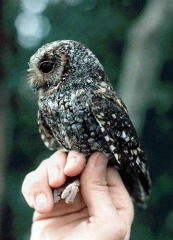 Flammulated Owl Otus flammeolus
Flammulated Owl Otus flammeolus
Size: 15–17 cm (6″–7″), Wingspan to 0.4 m (16″), Weight 60 gr (2.1 oz)
Nest: British Columbia
- A small owl slightly larger than a sparrow
- Have small, indistinct ear tufts, reddish edges on the facial disk
- Variegated red and/or grey plumage; light below with white and rust coloured markings
- The only small North American owl with dark eyes
- Uncommon and difficult to find in in coniferous woodlands and forest edges
- Nocturnal, roosting during the day in tree cavities, often those previously used by woodpeckers
- Nest in tree cavities, laying 3 or 4 white eggs
- Voice is a low, soft poot or podo podo repeated every few seconds
- Forages for insects at night and roosts in tree cavities during the day
- Eat primarily insects captured with their feet
Size: 60–82 cm (24″–33″), Wingspan to 1.3 m (52″), Weight 1,080 gr (2.4 lbs)
Nest: Yukon, Northwest Territories and British Columbia to Ontario
- Canada’s largest owl, and look much heavier than they are
- Very fluffy with a long tail and large head with yellow eyes, no ear tufts
- Plumage is grey with dark, smudgy markings; black chin spot bordered by white patches like a bow tie
- Large, heavily ringed facial disc makes the eyes look small
- Smaller eyes than most are an adaptation to diurnal hunting
- Voice is a series of up to 10 deep, muffled hoots
- Hunt for small mammals at night, or at dusk and dawn and can be active during the day
- Do not build nests but will enlarge an old one
- Lay 2 to 5 white eggs in a bulky stick nest located in dense conifers
- Do not migrate, but will irrupt into hunting areas with high rodent population cycles
- A very secretive bird, discovered by Europeans in America before they realized it also lives in Europe
- Provincial bird of Manitoba
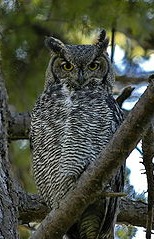 Great Horned Owl Bubo virginianus
Great Horned Owl Bubo virginianus
Size: 45–62 cm (18″–25″), Wingspan to 1.1 m (44″), Weight 1,400 gr (3.1 lbs)
Nest: Canada wide
- Broad head has prominent, wide spaced ear tufts
- Grayish or brownish above, mottled and streaked underneath, tawny orange facial disc with white throat
- Color is variable, ranging from nearly white in the Arctic to dark brown and grey in the south
- Voice is a series of deep muffled ho hoo hoo hoododo
- Active day or night; called the `winged tiger’ for their hunting ability
- Take medium sized prey such as rabbits, skunks, grouse
- Use a regular feeding post near the nest, where they bring prey to be torn up and eaten
- Have attacked people wearing fur hats, mistaking them for prey
- Does not migrate
- One of the first species to breed each winter, so the young are old enough to hunt returning species
- Do not breed until two years of age
- Nest in stick nests in trees, in caves, or on the ground, laying 2 or 3 white eggs
- Provincial bird of Alberta
- Flight speed 64 kmh (40 mph)
- Lifespan up to 29 years
Size: 32–40 cm (13″–16″), Wingspan to 1 m (36″), Weight 260 gr (9 oz)
Nest: Across southern Canada
- Nearly crow sized, with long ear tufts set close together
- Heavily streaked and barred on the belly; rusty facial disc
- Long black `ears’ are actually feather tufts which are flattened against the head in flight
- Usually solitary; a few may roost together in winter but they are so silent they are seldom seen
- The most secretive owl species, strictly nocturnal
- Inhabit dense deciduous and coniferous forests
- Pretend to be wounded to lure intruders away from the nest
- If disturbed on their roost, they raise ear tufts and compress feathers, looking like the stub of a tree limb
- Hunt small mammals at night, and roost next to tree trunks during the day
- Voice is a soft, low wooip every few seconds
- Generally silent except for breeding season
- Four or five white eggs laid in a stick nest
- Lifespan up to 27 years
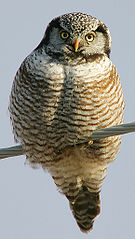 Northern Hawk Owl Surnia ulula
Northern Hawk Owl Surnia ulula
Size: 35–42 cm (14″–17″), Wingspan to 0.7 m (28″), Weight 320 gr (11 oz)
Nest: Across northern and central Canada
- Black bordered facial disc, underparts cross barred with dark brown, long tail, no ear tufts
- Found in open spruce woods and near bogs
- Perch on tree tops or poles to watch for small mammals
- Hawk-like posture and flight give them their name
- Often hovers over open ground
- Inhabit boreal and coniferous forests and muskeg
- More active during the day than other forest owls
- Very tame, and can be approached closely
- Voice is a series of popping popopopopopo
- Have been seen following farmers loading hay bales onto wagons and pouncing on uncovered mice
- Basically non-migratory but will retreat from northern-most part of range in winter
- Eat small mammals, birds and insects
- Lay 3 to 7 white eggs in the hollow tops of spruce trees, tree cavities or abandoned stick nests
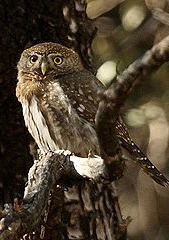 Northern Pygmy Owl Glaucididium gnoma
Northern Pygmy Owl Glaucididium gnoma
Size: 17–20 cm (7″–8″), Wingspan to 0.3 m (12″), Weight 70 gr (2.5 oz)
Nest: Southern British Columbia and Alberta
- A sparrow sized owl with a small round head
- Plumage is dark brown with pale bars, dark streaks and a spotted crown
- Dark head has white ‘eyebrow’ over the eyes
- Long tail is often moved or cocked sideways when perched
- Have two black spots on the back of the neck that look like eyes
- No soft wing feathers to muffle the sound of flight; rely on speed and agility instead of surprise·
- Inhabit areas of open coniferous or mixed deciduous forest
- Have a ferocity and strength out of proportion for their size, which is about that of a bluebird
- Voice is a series of toots repeated every few seconds
- Perch in trees to hunt for small birds
- Mainly nocturnal, but will hunt during the day
- Lay 3 to 6 white eggs in an existing tree cavity
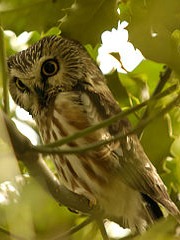 Northern Saw-whet Owl Aegolius acadicus
Northern Saw-whet Owl Aegolius acadicus
Size: 17–20 cm (7″–8″), Wingspan to 0.4 m (17″), Weight 80 gr (2.8 oz)
Nest: Across southern and central Canada
- The smallest northern owl
- Also called ‘Sparrow Owl’
- Large head has a prominent white ‘V’ on the face, and whiteish streaks
- Fluffy plumage is reddish brown above with reddish streaks on a lighter belly, and a reddish facial disc
- Yellow eyes, dark bill and no ear tufts
- Found in mixed coniferous and deciduous forests
- Active at night and roosts in dense trees during the day
- Usual food is insects but occasionally take small rodents or birds
- Voice is a series of low toit toit whistled toots
- Name comes from their two note call
- Remarkably tame owls and nearly fearless of man
- Lay 5 or 6 white eggs in an existing tree cavity
- Lifespan up to 17 years
Western Otus kenicottii Nest: British Columbia
Eastern Otus asio Nest: Southern Saskatchewan through to Quebec
Size: 17–25 cm (7″–10″), Wingspan to 0.5 m (20″), Weight 180 gr (6 oz)
- Plumage variable; brownish red to gray
- Small and stocky; a large head, broad wings and short tail
- Ear tufts prominent when raised, and they have a flat headed look when tufts are down
- Strictly nocturnal, foraging at night for insects and rodents
- Usually solitary
- Roost in tree cavities during the day
- Nest in tree cavities, laying 3-8 white eggs
- Uncommon but widespread in forests, swamps, parks
- Voice is a series of shot pwep pwep pwep whistles
- Call is really a soft, mournful whinny that aroused fear and suspicion among early settlers
- Lifespan up to 13 years
Size: 32–42 cm (13″–17″), Wingspan to 1 m (38″), Weight 350 gr (12 oz)
Nest: Across Canada in grassland areas
- Crow sized and slender, with barely visible ear tufts
- Pale tawny brown overall with a heavily streaked underside and a dark triangle around each eye
- Long-winged owl of open country, marshes and tundra
- Have a high pitched, rasping call like the bark of a small dog
- Voice is a muffled poo poo poo in a quick series
- Fly low over the ground and hover briefly before swooping down
- Roost on the ground, occasionally in large groups
- Gregarious in winter and may gather where prey is abundant
- Less nocturnal than other owls and often seen in daylight
- Eat rodents and small mammals
- Adults will perform `crippled bird’ act to lure intruders from nest
- Live in the grasslands of every continent except Australia
- Flight speed 42 kmh (26 mph)
- Suffers from loss of natural habitat conversion to agriculture
- Listed as a species of Special Concern on COSEWIC
Size: 50–67 cm (20″–27″), Wingspan to 1.3 m (52″), Weight 1,830 gr (4 lbs)
Nest: Open Arctic tundra
- Mostly white in all plumages; first year birds have dark barring on the body and head; yellow eye
- Dark bars and spots heaviest on juveniles and females; old males may be pure white
- Winters in open fields in southern Canada and northern USA, perching on fence posts or poles
- Canada’s heaviest owl
- Completely encased in feathers from their toes and foot pads to the tip of their beak
- Most active at night, hunting small rodents and birds
- Require very large territories, up to 10 sq km (4 sq mi) due to the scarcity of prey on the tundra
- Hoots can be heard more than 3 km (2 mi) away
- Has the most northerly distribution of any owl
- Lemming population determines the number of eggs; if rodents are abundant up to 13 can be laid
- Nest in a shallow ground depression lined with feathers
- Flight speed 80 kmh (50 mph)
- Provincial bird of Quebec
- Lifespan up to 14 years
 Spotted Owl Strix occidentalis
Spotted Owl Strix occidentalis
Size: 40–47 cm (16″–19″), Wingspan to 1.1 m (40″), Weight 610 gr (1.3 lb)
Nest: Southwestern British Columbia
- Large, rounded headed owl with white spotting on head, back and underparts; dark eyes
- Found in canyons and humid forests of coniferous trees
- Strictly nocturnal, and seldom seen because of their retiring habits during the day
- One of their calls is similar to that of a baying hound
- Voice is a strong, rhythmic hooting whup hoo hoo hoooo
- Pairs mate for life
- Lay 2-3 white eggs on the bare floor of a tree cavity
- Mates occupy a home range of 1,000 ha (2,500 acres)
- Hybridizes with barred owl where ranges overlap
- Prey on small rodents, birds and insects
- Decreasing in numbers and range where they can be found
- Very endangered due to loss of first growth forest habitat



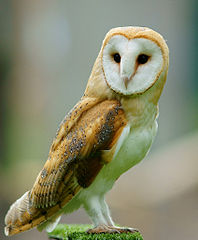

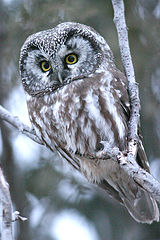

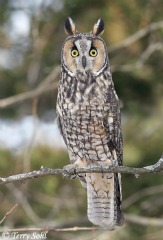
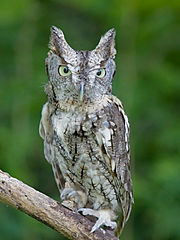
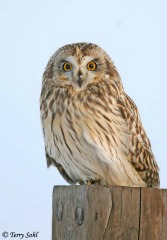

Thanks for helping me identify a great grey owl i saw last week north of lac la biche alberta. It was sitting on a fence post during the day. What a bird! Very large. It flew off before i could back up and take a picture.
How cool that you are finding owl pellets! They are not from a barn owl, however, as they are found only in the most southerly portions of BC, then in eastern Canada. If you have pellets on your deck it means an owl is perching near there for fairly long periods of time. Could be your GHO!
Thanks for the page and great info. Have identified the pellets I’ve been seeing around the yard and on deck: barn owl. Have not seen it, but thought I heard a call early this morning. This fall have yet to hear or see our resident great horned owl. Whitehorse, Lake Laberge area.
You are seeing a Snowy Owl. High Level is on their migration route south for the winter. If the hunting and the weather is good, they may hang around for awhile to bulk up for the rest of their trip. And maybe you could close your curtains at night – I bet your poor parrot nearly had a heart attack!
Hi, can you tell me which owls in Northern Canada turn white in winter? (Or is this a Snowy Owl…?) I live in High Level, Alberta, only about an hour and a half south of the Northwest Territories border, and the last few mornings (7 am, dark)I have seen a white owl perched on a fence on my way to work…dirt road out in farm country…when I drive by he takes off and flies beside the car for a bit…then veers off. Not huge, medium sized owl…incredibly beautiful. You might be interested to know I had a Great Grey Owl try to attack my parrot that was perched in the living room…curtains open, 2nd floor, dark at night, and he plowed right into the window. I ran out to make sure he was ok, he was groggy but no blood, flew off, two great flaps and across the road…unbelievably beautiful. Beak and talons were huge, wasn’t sure what I was going to do if the poor bugger did need help…Thanks so much!
Pingback: The Whoo’s Whooo of Altona Forest | My Altona Forest
Hi! I just realized there are some complaints I have. I’d like to know how flying helps the Northern Hawk Owl (Or any other owl) to survive in the wild. And what movement gives them the thrust to fly forwards.
Thanks for the information! It’s very useful! Especially for the Northern Hawk Owl
Our apologies Greg. Please see our email of today’s date.
The image of the screech owl posted on this page has been taken from Wikipedia.
It is copyrighted, but you may use it under a creative commons license that requires you to provide proper attribution consisting of a link to the original image or insertion of the caption/note “Photo by Greg Hume”. Please provide this attribution or remove the image.
Original image posted here: http://en.wikipedia.org/wiki/File:Megascops_asio-gray.jpg
Regards,
Greg Hume